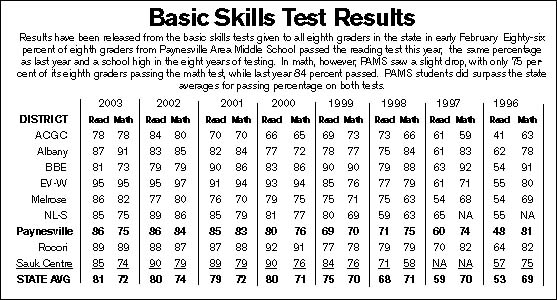Mathematics results dip on basic skills test
In reading, 86 percent of PAMS's 104 eighth graders passed the test, matching the school's highest passing percentage from last year.
In math, however, 75 percent of eighth graders at PAMS passed the test, down from 84 percent in 2002, which is also the school's highest passing percentage.
PAMS eighth graders did surpass state averages for passing percentages and for average test scores once again. Statewide, 81 percent of eighth graders passed the reading test and 71 percent passed the math test.
The Minnesota Basic Skills Tests are required for graduation. They have been given for eight years, since 1996. Students may retake the test in the summer or in February until they pass the test.
Principal Deb Gillman, who serves as the district's curriculum coordinator, noted that too much emphasis can be put on passing percentage, especially with the relatively small class sizes in Paynesville. Since PAMS has had 100 students per class, the results from each student are a percentage point. This can lead to some swings from year to year, if only based on the relative academic strengths of that particular eighth grade class.
Still, Gillman expressed concerns over the district's math results. Since 1996, reading results at PAMS have shown steady improvement, while math results have peaked but not shown as much overall improvement.
For instance, in 1996 only 48 percent of eighth graders at PAMS passed the reading test. Now, for the last two years, 86 percent have passed. In math, 81 percent passed the test in 1996, and 75 percent passed this year.
Gillman said those first test results really caused the district to focus on its reading curriculum. Since that time, the school has added the Accelerated Reading program in the middle school and stressed comprehension and reading nonfiction, especially newspapers since many of the questions on the reading test deal with newspaper articles.
Gillman also noted that the school has done more to prepare the students for the actual test day, from developing test strategies to having juice and granola bars for the eighth graders.
"For the last six years, we've worked really hard to improve our reading," said Gillman. "And we've done that. We've improved our reading scores dramatically."
Math scores, on the other hand, have always been fine and therefore did not demand as much attention, said Gillman.
But while average test scores in reading at PAMS have improved from 619 (out of 750) in 1999 to 650 this year, average math scores started at 618 (out of 780) in 1999, peaked at 647 in 2002, and dropped back to 633 in 2003.
District staff is already working on a curriculum review in math, said Gillman. While their recommendations are not available yet, Gillman said they will look for low-cost ways to improve the math curriculum. One change could be to spend more time on math each day in elementary classrooms.
This year's eighth graders also took state testing as fifth graders, and those test results indicated that 73 percent were on pace to pass the reading and 64 percent were on pace to pass the math. This seems to indicate that the ten-percentage-point gap in test results as eighth graders may have its origin much earlier.
In reading this year, 12 eighth graders from PAMS had perfect papers, 12 had one wrong, and 19 had only two wrong, indicating that nearly half the class was close to a perfect test, said Gillman. In math, only two students had perfect tests, four had one wrong, and seven had two wrong.
Even with the Legislature discussing the Profiles of Learning, Gillman warned that testing is not going to go away. In fact, the federal "No Child Left Behind" law will actually require testing in grades 3-8 and grade 10 instead of just grades 3, 5, 8, and 10 as required now. It also requires science testing, not currently required in Minnesota.
Plus, the federal law requires that schools make sure that all student groups Ð ethnic, social class, students with disabilities, and students learning English as a second language Ð make progress towards being proficient in reading and math. By 2014, in 12 years, all groups of students must be equally proficient in these subject areas.
The federal law also includes consequences for schools who repeatedly score below average on these tests.
"We've got to keep moving ahead. No one wants to be below average. Everyone is going to be trying to improve and thus raising the average," said Gillman.

Contact the author at editor@paynesvillepress.com • Return to News Menu
Home | Marketplace | Community